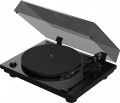Model
Model of the pickup (cartridge) supplied with the player. The pickup is one of the most important parts of any vinyl player, the quality of the received sound largely depends on its quality. Knowing the name of the model, you can find detailed data on it and determine how satisfied you are with this particular cartridge.
Output level
The signal level at the output of the pickup supplied with the player is, in fact, the power of the signal coming from the pickup to the phono stage. This parameter is necessary, first of all, in cases where the player is planned to be connected to an external phono stage: such equipment must be designed for the corresponding power of the signal coming from the pickup.
Downforce
The force of pressing the needle on the plate, which the complete pickup (cartridge) is designed for.
This force depends on the rigidity (compliance) of the needle: the greater the clamping force, the harder the cartridge, respectively, the less pliable it is. It is also believed that less pressing force wears out the record less, but it cannot be said that "light" cartridges are definitely better — there are many other nuances. So in fact, information about the pressing force of a complete pickup is needed mainly in case of its replacement. Usually, the pressing force provided by the arm of the turntable is regulated within these limits, so the new cartridge must also be rated for the same values of downforce — otherwise there is a chance that the turntable will not be able to correctly align.
Pickup weight
The weight of the pickup (cartridge) supplied with the turntable.
The weight of the cartridge determines the characteristics of balancing the tonearm to set the optimal tracking force. However, pickups in set are usually optimally compatible with the corresponding tonearms, so there are no problems with adjusting the turntable. But when buying a replacement cartridge, you should pay attention to this parameter: it is advisable that the new cartridge does not differ too much in weight from the old one, otherwise the tonearm adjustment range may not be enough for the correct balance.
Shape
The shape of the complete tonearm (viewed from on top). Modern players may have both
straight and
S-shaped or
J-shaped tonearms. It is impossible to say for sure which of them is better: the advantage of the first option is its light weight, the second and third ones are its greater length and low resonant frequency, which reduces the likelihood of interference. Therefore, in practice, the choice depends on the specific situation and personal preferences.
Material
The main material used in the construction of a complete tonearm.
-
Aluminum. This is a fairly lightweight and durable material that has average characteristics in terms of sound quality: it does not dampen extraneous vibrations as well as carbon, but for entry-level and mid-level turntables this is quite enough; in expensive models, you can use other methods of eliminating interference, and aluminum is noticeably cheaper.
—
Carbon. A high-quality material that is lighter in weight and has more advanced anti-resonance properties than the metal described above. The main disadvantage of carbon fiber is its rather high cost.
- Plastic. Plastic is inexpensive, but this is perhaps its only key advantage: the performance characteristics of this material are quite modest. That is why it is used extremely rarely - mainly in retro-style players, where a plastic tonearm is a necessary part from a design point of view.
Tonearm effective length
The effective length of a tonearm in set is the distance from the attachment point (axis of rotation) to the stylus.
This indicator is important primarily for rotary tonearms: the longer the length, the lower the angular error, the smaller the discrepancy between the direction of movement of the track and the longitudinal axis of the pickup (for more details, see “Type”) and the lower the level of corresponding distortion. In addition, a longer length reduces the resonant frequency and reduces the likelihood of distortion. On the other hand, a longer tonearm turns out to be heavier, which requires certain technical tricks and can also negatively affect the purity of the sound. Therefore, a large length is not always a guarantee of high quality – you should also pay attention to weight (see below).
Tonearm weight
Operating weight of the complete tonearm. It is believed that this indicator should be as low as possible — in order not to create excessive pressure and to minimize the wear of the needle and records. On the other hand, a rigid pickup on a light arm can bounce on uneven records, and in general, such a discrepancy does not improve the sound quality. However, complete tonearms are usually optimally compatible with complete pickups; therefore, you should only be interested in compatibility when buying a cartridge of a different model.
Speed control
A method for switching the disc rotation speed provided in the player.
—
Manual. This option is only found on belt driven models (see above). It provides the transfer of the belt to another pulley, due to which the gear ratio and, accordingly, the rotation speed change. This method is not as fast and convenient as automatic, however, it allows you to do without unnecessary electronic circuits (many audiophiles appreciate this feature, because additional electronics can interfere and degrade sound quality).
—
Electronic. Speed switching, carried out by changing the parameters of the electric motor — usually, the user just needs to press a button or move the regulator. This method is much faster and more convenient than mechanical, and for direct drive models (see above) is generally the only possible option. However, the electronics responsible for switching the speed affect the cost of the player and can become a source of additional interference; however, the latter can be compensated by installing control circuits in an external power supply (see below).

